Marketing Management: SWOT Analysis, STP, Marketing Mix and Recommendations for Burberry
VerifiedAdded on 2023/06/18
|17
|4456
|100
AI Summary
This report provides a detailed analysis of Burberry's SWOT, STP, Marketing Mix and recommendations. It includes a discussion on the strengths, weaknesses, opportunities, and threats of Burberry, its segmentation, targeting and positioning strategies, and the 4P's of marketing. The report also provides recommendations for Burberry to improve its market share and overcome challenges.
Contribute Materials
Your contribution can guide someone’s learning journey. Share your
documents today.
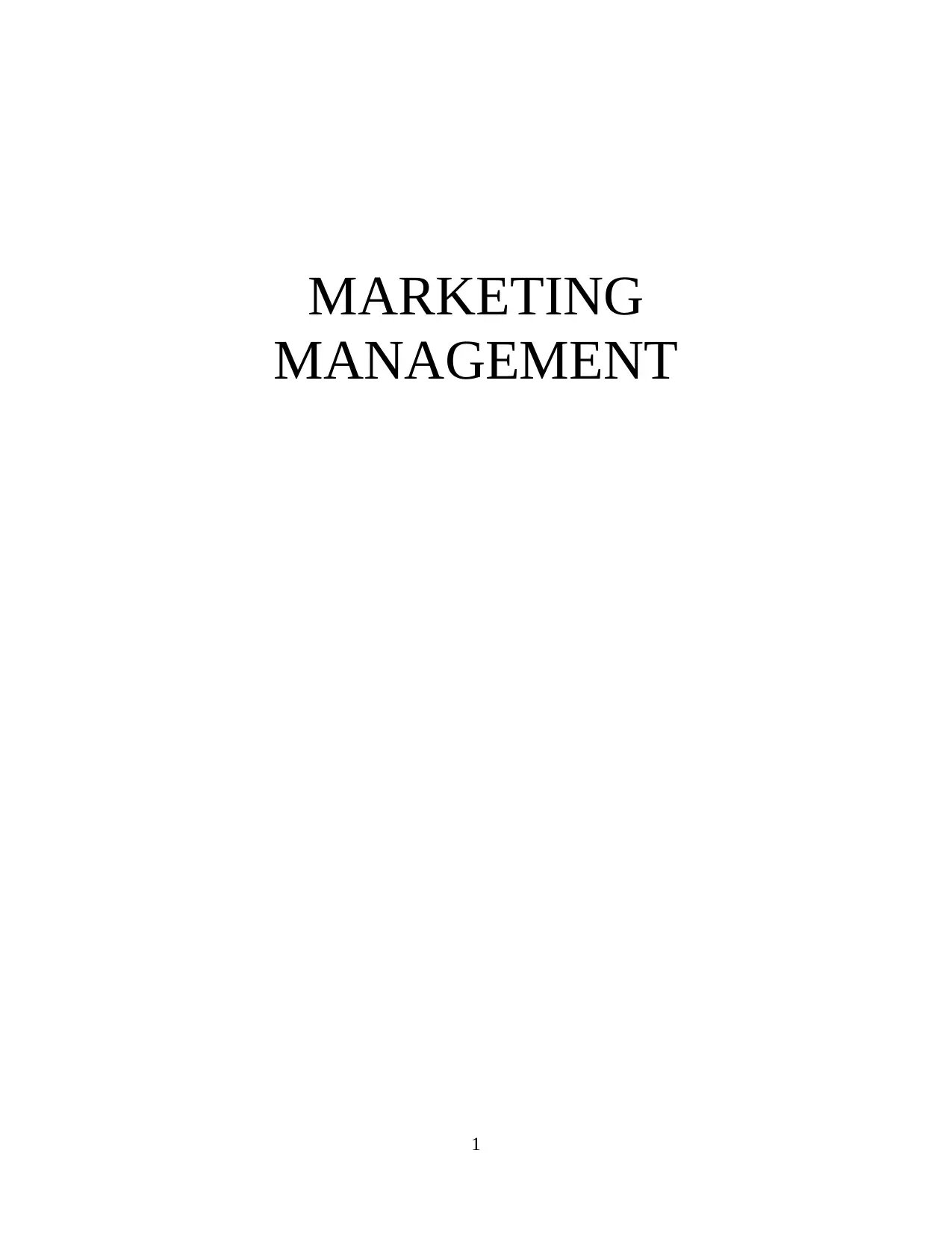
MARKETING
MANAGEMENT
1
MANAGEMENT
1
Secure Best Marks with AI Grader
Need help grading? Try our AI Grader for instant feedback on your assignments.
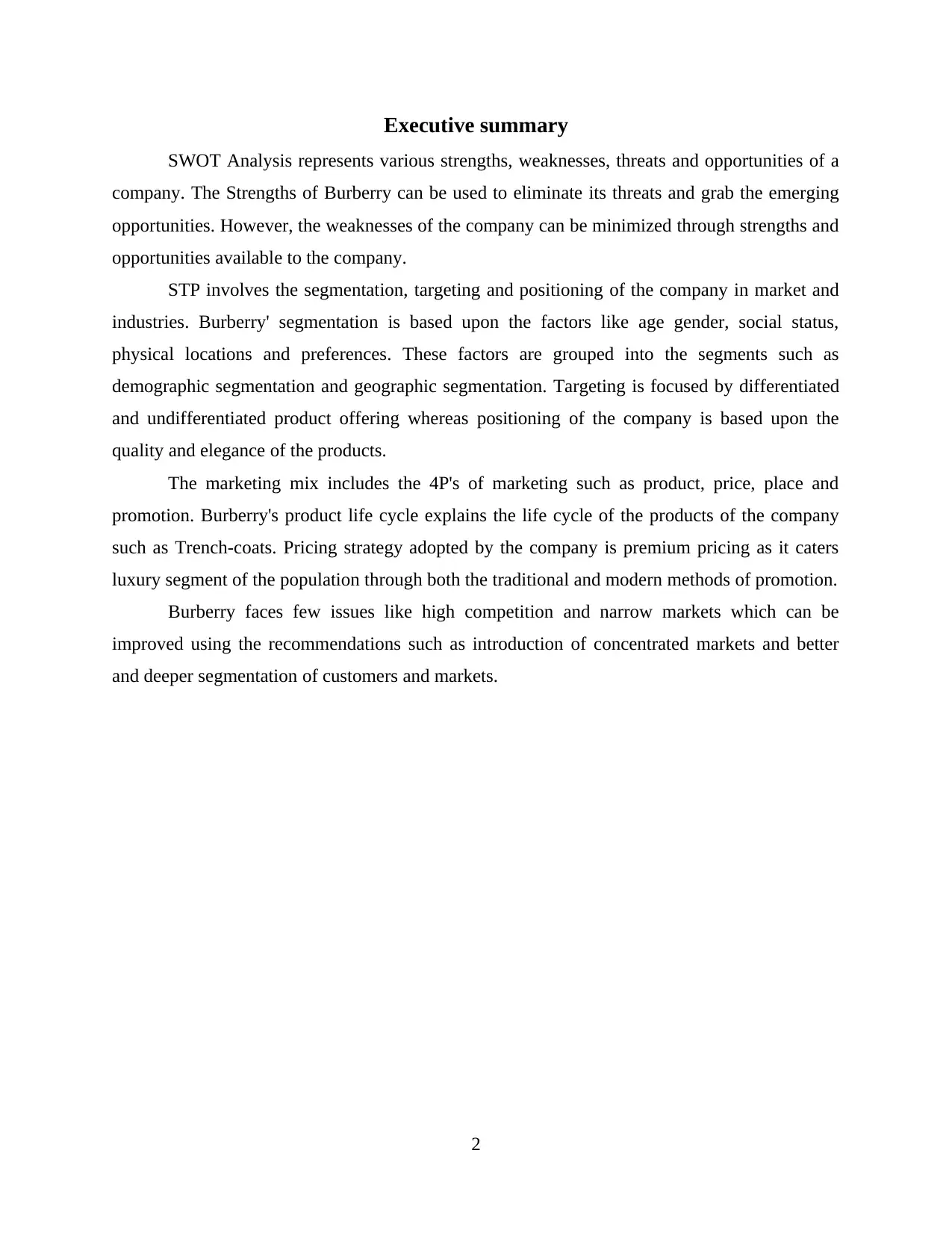
Executive summary
SWOT Analysis represents various strengths, weaknesses, threats and opportunities of a
company. The Strengths of Burberry can be used to eliminate its threats and grab the emerging
opportunities. However, the weaknesses of the company can be minimized through strengths and
opportunities available to the company.
STP involves the segmentation, targeting and positioning of the company in market and
industries. Burberry' segmentation is based upon the factors like age gender, social status,
physical locations and preferences. These factors are grouped into the segments such as
demographic segmentation and geographic segmentation. Targeting is focused by differentiated
and undifferentiated product offering whereas positioning of the company is based upon the
quality and elegance of the products.
The marketing mix includes the 4P's of marketing such as product, price, place and
promotion. Burberry's product life cycle explains the life cycle of the products of the company
such as Trench-coats. Pricing strategy adopted by the company is premium pricing as it caters
luxury segment of the population through both the traditional and modern methods of promotion.
Burberry faces few issues like high competition and narrow markets which can be
improved using the recommendations such as introduction of concentrated markets and better
and deeper segmentation of customers and markets.
2
SWOT Analysis represents various strengths, weaknesses, threats and opportunities of a
company. The Strengths of Burberry can be used to eliminate its threats and grab the emerging
opportunities. However, the weaknesses of the company can be minimized through strengths and
opportunities available to the company.
STP involves the segmentation, targeting and positioning of the company in market and
industries. Burberry' segmentation is based upon the factors like age gender, social status,
physical locations and preferences. These factors are grouped into the segments such as
demographic segmentation and geographic segmentation. Targeting is focused by differentiated
and undifferentiated product offering whereas positioning of the company is based upon the
quality and elegance of the products.
The marketing mix includes the 4P's of marketing such as product, price, place and
promotion. Burberry's product life cycle explains the life cycle of the products of the company
such as Trench-coats. Pricing strategy adopted by the company is premium pricing as it caters
luxury segment of the population through both the traditional and modern methods of promotion.
Burberry faces few issues like high competition and narrow markets which can be
improved using the recommendations such as introduction of concentrated markets and better
and deeper segmentation of customers and markets.
2
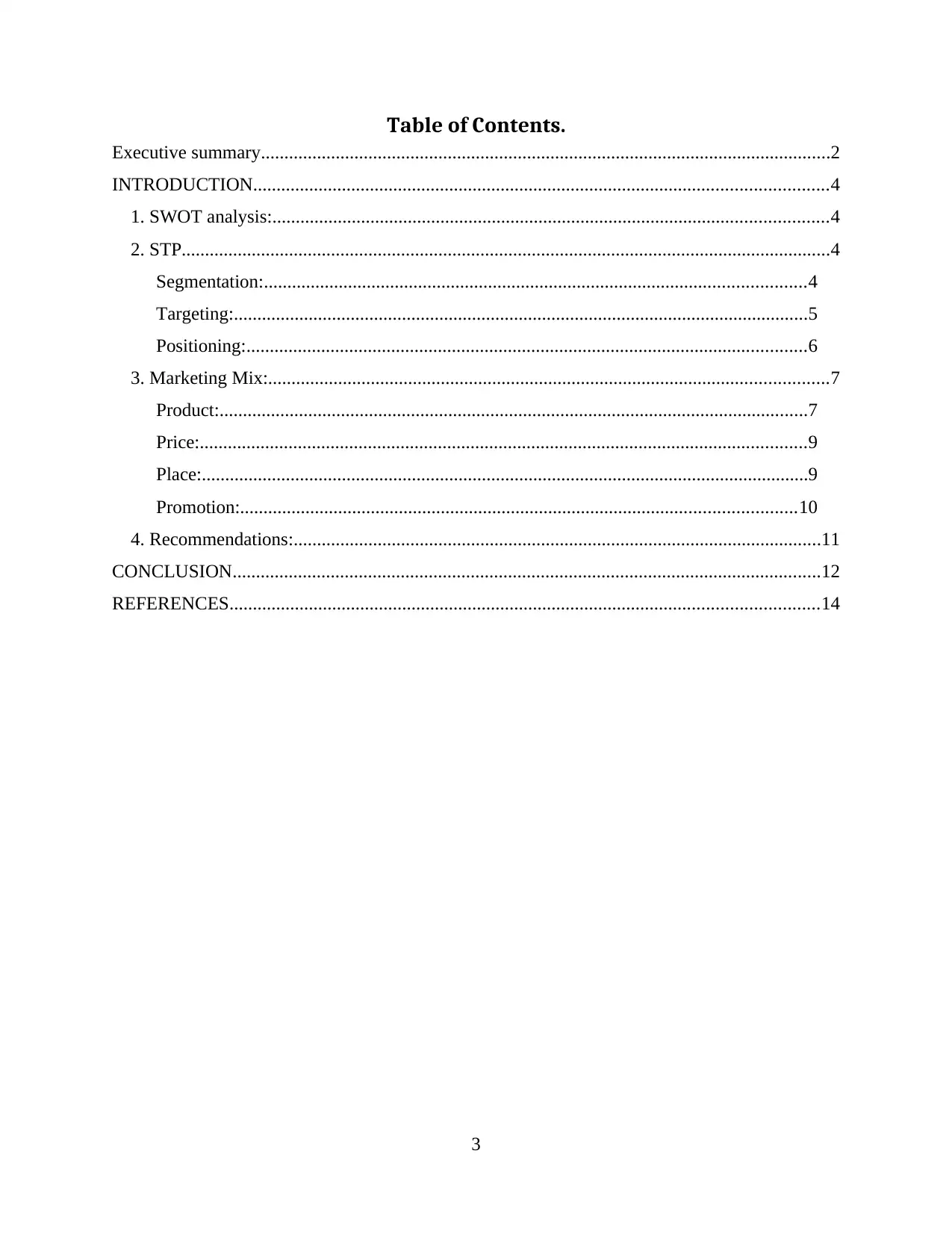
Table of Contents.
Executive summary..........................................................................................................................2
INTRODUCTION...........................................................................................................................4
1. SWOT analysis:.......................................................................................................................4
2. STP...........................................................................................................................................4
Segmentation:....................................................................................................................4
Targeting:...........................................................................................................................5
Positioning:........................................................................................................................6
3. Marketing Mix:........................................................................................................................7
Product:..............................................................................................................................7
Price:..................................................................................................................................9
Place:..................................................................................................................................9
Promotion:.......................................................................................................................10
4. Recommendations:.................................................................................................................11
CONCLUSION..............................................................................................................................12
REFERENCES..............................................................................................................................14
3
Executive summary..........................................................................................................................2
INTRODUCTION...........................................................................................................................4
1. SWOT analysis:.......................................................................................................................4
2. STP...........................................................................................................................................4
Segmentation:....................................................................................................................4
Targeting:...........................................................................................................................5
Positioning:........................................................................................................................6
3. Marketing Mix:........................................................................................................................7
Product:..............................................................................................................................7
Price:..................................................................................................................................9
Place:..................................................................................................................................9
Promotion:.......................................................................................................................10
4. Recommendations:.................................................................................................................11
CONCLUSION..............................................................................................................................12
REFERENCES..............................................................................................................................14
3
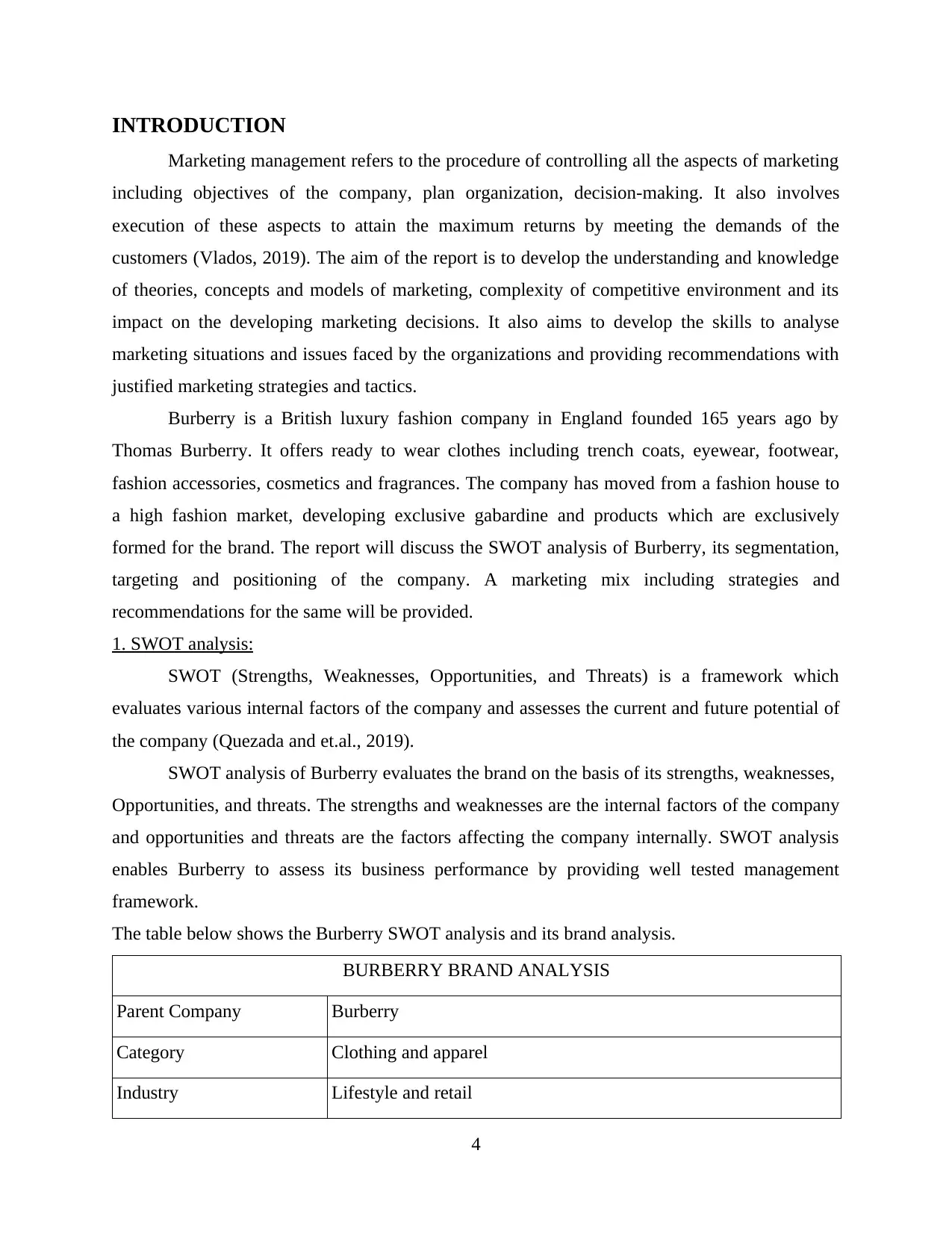
INTRODUCTION
Marketing management refers to the procedure of controlling all the aspects of marketing
including objectives of the company, plan organization, decision-making. It also involves
execution of these aspects to attain the maximum returns by meeting the demands of the
customers (Vlados, 2019). The aim of the report is to develop the understanding and knowledge
of theories, concepts and models of marketing, complexity of competitive environment and its
impact on the developing marketing decisions. It also aims to develop the skills to analyse
marketing situations and issues faced by the organizations and providing recommendations with
justified marketing strategies and tactics.
Burberry is a British luxury fashion company in England founded 165 years ago by
Thomas Burberry. It offers ready to wear clothes including trench coats, eyewear, footwear,
fashion accessories, cosmetics and fragrances. The company has moved from a fashion house to
a high fashion market, developing exclusive gabardine and products which are exclusively
formed for the brand. The report will discuss the SWOT analysis of Burberry, its segmentation,
targeting and positioning of the company. A marketing mix including strategies and
recommendations for the same will be provided.
1. SWOT analysis:
SWOT (Strengths, Weaknesses, Opportunities, and Threats) is a framework which
evaluates various internal factors of the company and assesses the current and future potential of
the company (Quezada and et.al., 2019).
SWOT analysis of Burberry evaluates the brand on the basis of its strengths, weaknesses,
Opportunities, and threats. The strengths and weaknesses are the internal factors of the company
and opportunities and threats are the factors affecting the company internally. SWOT analysis
enables Burberry to assess its business performance by providing well tested management
framework.
The table below shows the Burberry SWOT analysis and its brand analysis.
BURBERRY BRAND ANALYSIS
Parent Company Burberry
Category Clothing and apparel
Industry Lifestyle and retail
4
Marketing management refers to the procedure of controlling all the aspects of marketing
including objectives of the company, plan organization, decision-making. It also involves
execution of these aspects to attain the maximum returns by meeting the demands of the
customers (Vlados, 2019). The aim of the report is to develop the understanding and knowledge
of theories, concepts and models of marketing, complexity of competitive environment and its
impact on the developing marketing decisions. It also aims to develop the skills to analyse
marketing situations and issues faced by the organizations and providing recommendations with
justified marketing strategies and tactics.
Burberry is a British luxury fashion company in England founded 165 years ago by
Thomas Burberry. It offers ready to wear clothes including trench coats, eyewear, footwear,
fashion accessories, cosmetics and fragrances. The company has moved from a fashion house to
a high fashion market, developing exclusive gabardine and products which are exclusively
formed for the brand. The report will discuss the SWOT analysis of Burberry, its segmentation,
targeting and positioning of the company. A marketing mix including strategies and
recommendations for the same will be provided.
1. SWOT analysis:
SWOT (Strengths, Weaknesses, Opportunities, and Threats) is a framework which
evaluates various internal factors of the company and assesses the current and future potential of
the company (Quezada and et.al., 2019).
SWOT analysis of Burberry evaluates the brand on the basis of its strengths, weaknesses,
Opportunities, and threats. The strengths and weaknesses are the internal factors of the company
and opportunities and threats are the factors affecting the company internally. SWOT analysis
enables Burberry to assess its business performance by providing well tested management
framework.
The table below shows the Burberry SWOT analysis and its brand analysis.
BURBERRY BRAND ANALYSIS
Parent Company Burberry
Category Clothing and apparel
Industry Lifestyle and retail
4
Secure Best Marks with AI Grader
Need help grading? Try our AI Grader for instant feedback on your assignments.
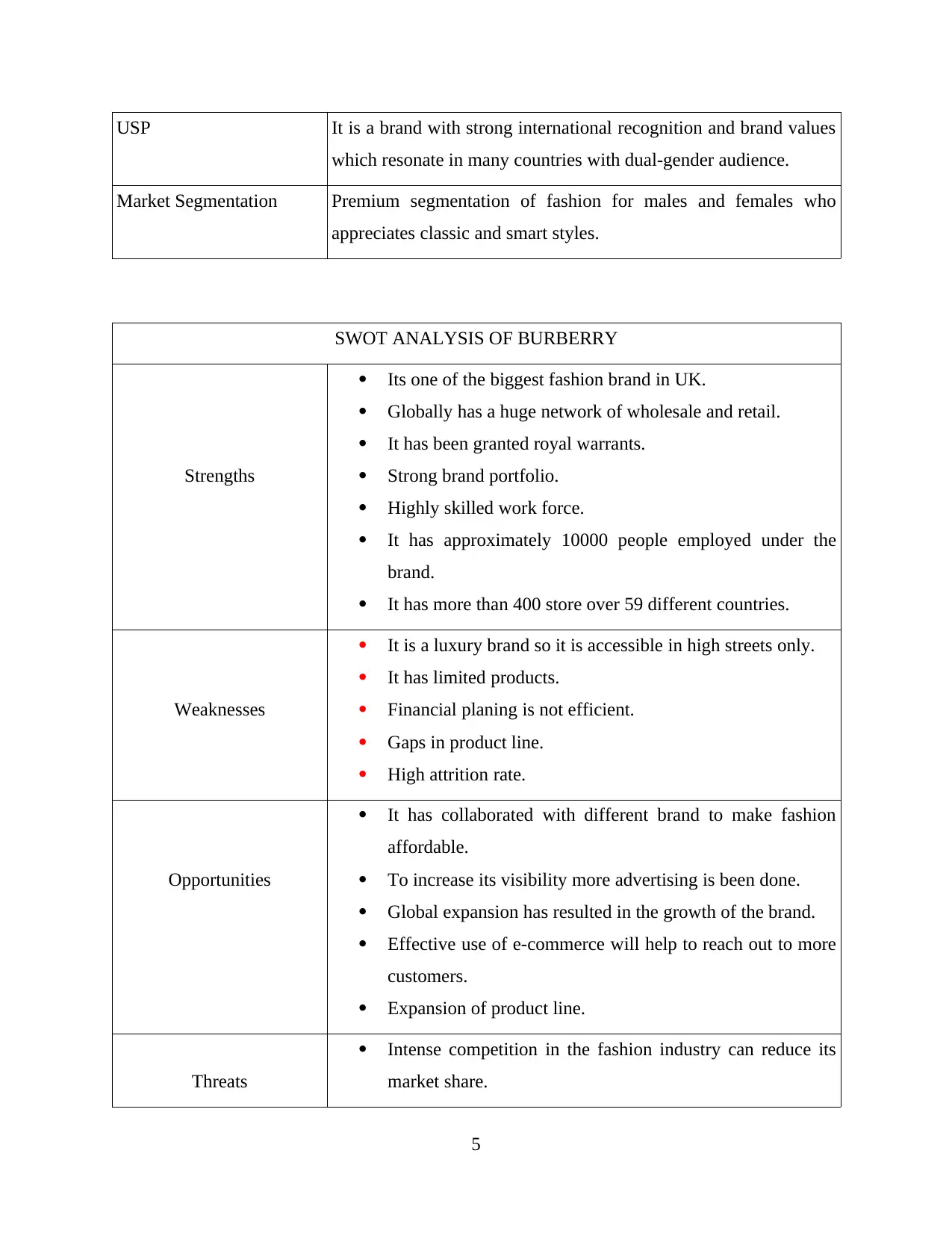
USP It is a brand with strong international recognition and brand values
which resonate in many countries with dual-gender audience.
Market Segmentation Premium segmentation of fashion for males and females who
appreciates classic and smart styles.
SWOT ANALYSIS OF BURBERRY
Strengths
Its one of the biggest fashion brand in UK.
Globally has a huge network of wholesale and retail.
It has been granted royal warrants.
Strong brand portfolio.
Highly skilled work force.
It has approximately 10000 people employed under the
brand.
It has more than 400 store over 59 different countries.
Weaknesses
It is a luxury brand so it is accessible in high streets only.
It has limited products.
Financial planing is not efficient.
Gaps in product line.
High attrition rate.
Opportunities
It has collaborated with different brand to make fashion
affordable.
To increase its visibility more advertising is been done.
Global expansion has resulted in the growth of the brand.
Effective use of e-commerce will help to reach out to more
customers.
Expansion of product line.
Threats
Intense competition in the fashion industry can reduce its
market share.
5
which resonate in many countries with dual-gender audience.
Market Segmentation Premium segmentation of fashion for males and females who
appreciates classic and smart styles.
SWOT ANALYSIS OF BURBERRY
Strengths
Its one of the biggest fashion brand in UK.
Globally has a huge network of wholesale and retail.
It has been granted royal warrants.
Strong brand portfolio.
Highly skilled work force.
It has approximately 10000 people employed under the
brand.
It has more than 400 store over 59 different countries.
Weaknesses
It is a luxury brand so it is accessible in high streets only.
It has limited products.
Financial planing is not efficient.
Gaps in product line.
High attrition rate.
Opportunities
It has collaborated with different brand to make fashion
affordable.
To increase its visibility more advertising is been done.
Global expansion has resulted in the growth of the brand.
Effective use of e-commerce will help to reach out to more
customers.
Expansion of product line.
Threats
Intense competition in the fashion industry can reduce its
market share.
5
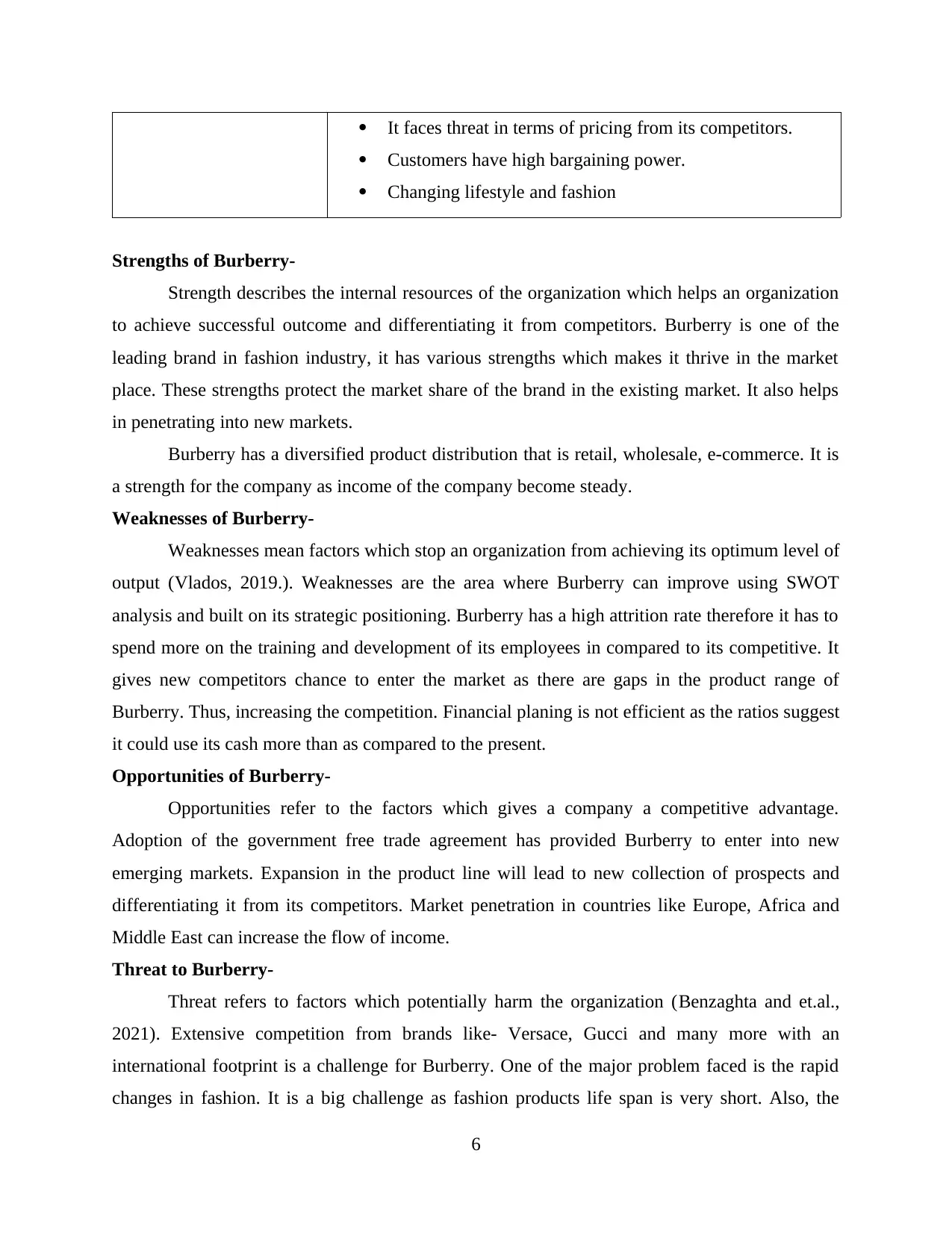
It faces threat in terms of pricing from its competitors.
Customers have high bargaining power.
Changing lifestyle and fashion
Strengths of Burberry-
Strength describes the internal resources of the organization which helps an organization
to achieve successful outcome and differentiating it from competitors. Burberry is one of the
leading brand in fashion industry, it has various strengths which makes it thrive in the market
place. These strengths protect the market share of the brand in the existing market. It also helps
in penetrating into new markets.
Burberry has a diversified product distribution that is retail, wholesale, e-commerce. It is
a strength for the company as income of the company become steady.
Weaknesses of Burberry-
Weaknesses mean factors which stop an organization from achieving its optimum level of
output (Vlados, 2019.). Weaknesses are the area where Burberry can improve using SWOT
analysis and built on its strategic positioning. Burberry has a high attrition rate therefore it has to
spend more on the training and development of its employees in compared to its competitive. It
gives new competitors chance to enter the market as there are gaps in the product range of
Burberry. Thus, increasing the competition. Financial planing is not efficient as the ratios suggest
it could use its cash more than as compared to the present.
Opportunities of Burberry-
Opportunities refer to the factors which gives a company a competitive advantage.
Adoption of the government free trade agreement has provided Burberry to enter into new
emerging markets. Expansion in the product line will lead to new collection of prospects and
differentiating it from its competitors. Market penetration in countries like Europe, Africa and
Middle East can increase the flow of income.
Threat to Burberry-
Threat refers to factors which potentially harm the organization (Benzaghta and et.al.,
2021). Extensive competition from brands like- Versace, Gucci and many more with an
international footprint is a challenge for Burberry. One of the major problem faced is the rapid
changes in fashion. It is a big challenge as fashion products life span is very short. Also, the
6
Customers have high bargaining power.
Changing lifestyle and fashion
Strengths of Burberry-
Strength describes the internal resources of the organization which helps an organization
to achieve successful outcome and differentiating it from competitors. Burberry is one of the
leading brand in fashion industry, it has various strengths which makes it thrive in the market
place. These strengths protect the market share of the brand in the existing market. It also helps
in penetrating into new markets.
Burberry has a diversified product distribution that is retail, wholesale, e-commerce. It is
a strength for the company as income of the company become steady.
Weaknesses of Burberry-
Weaknesses mean factors which stop an organization from achieving its optimum level of
output (Vlados, 2019.). Weaknesses are the area where Burberry can improve using SWOT
analysis and built on its strategic positioning. Burberry has a high attrition rate therefore it has to
spend more on the training and development of its employees in compared to its competitive. It
gives new competitors chance to enter the market as there are gaps in the product range of
Burberry. Thus, increasing the competition. Financial planing is not efficient as the ratios suggest
it could use its cash more than as compared to the present.
Opportunities of Burberry-
Opportunities refer to the factors which gives a company a competitive advantage.
Adoption of the government free trade agreement has provided Burberry to enter into new
emerging markets. Expansion in the product line will lead to new collection of prospects and
differentiating it from its competitors. Market penetration in countries like Europe, Africa and
Middle East can increase the flow of income.
Threat to Burberry-
Threat refers to factors which potentially harm the organization (Benzaghta and et.al.,
2021). Extensive competition from brands like- Versace, Gucci and many more with an
international footprint is a challenge for Burberry. One of the major problem faced is the rapid
changes in fashion. It is a big challenge as fashion products life span is very short. Also, the
6
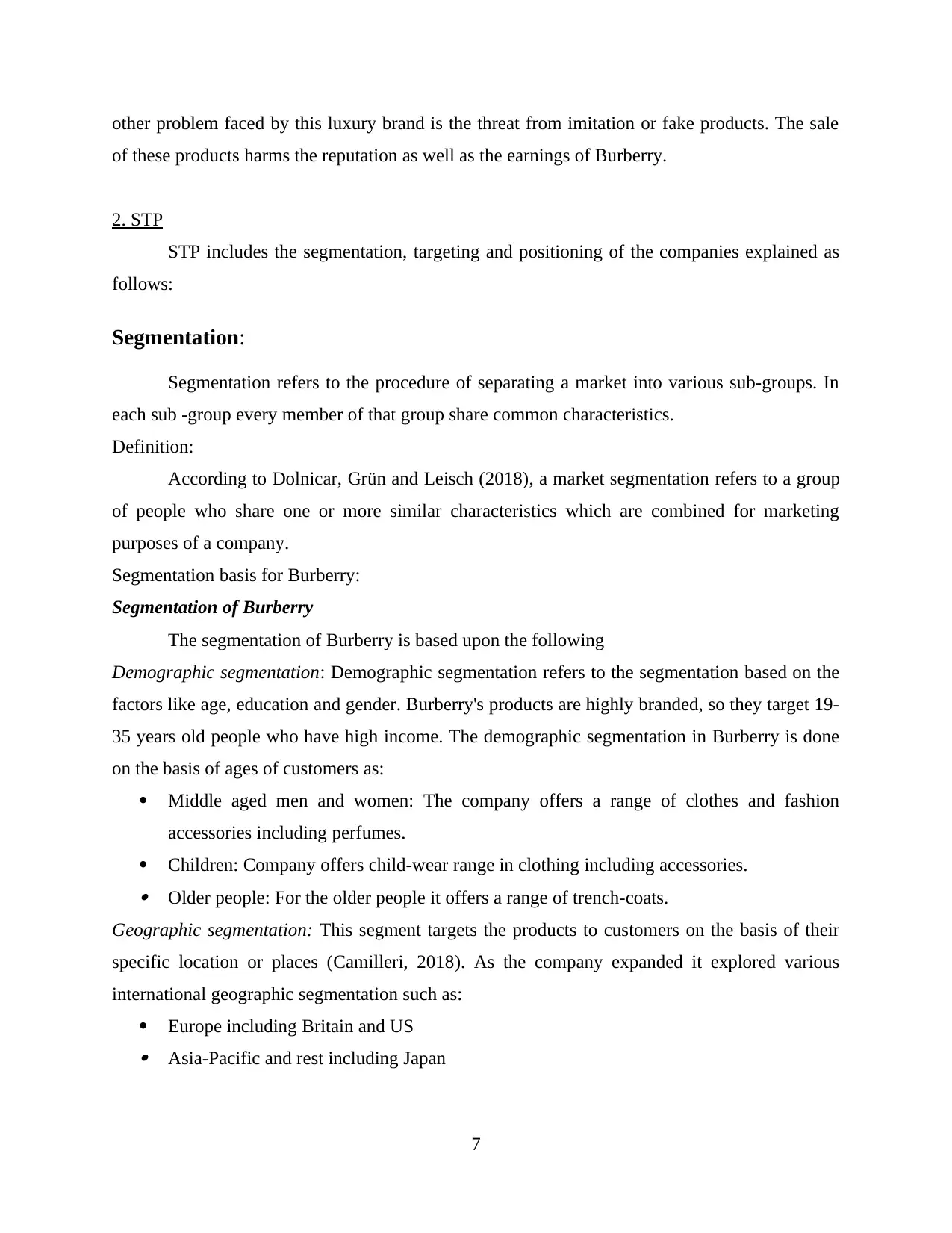
other problem faced by this luxury brand is the threat from imitation or fake products. The sale
of these products harms the reputation as well as the earnings of Burberry.
2. STP
STP includes the segmentation, targeting and positioning of the companies explained as
follows:
Segmentation:
Segmentation refers to the procedure of separating a market into various sub-groups. In
each sub -group every member of that group share common characteristics.
Definition:
According to Dolnicar, Grün and Leisch (2018), a market segmentation refers to a group
of people who share one or more similar characteristics which are combined for marketing
purposes of a company.
Segmentation basis for Burberry:
Segmentation of Burberry
The segmentation of Burberry is based upon the following
Demographic segmentation: Demographic segmentation refers to the segmentation based on the
factors like age, education and gender. Burberry's products are highly branded, so they target 19-
35 years old people who have high income. The demographic segmentation in Burberry is done
on the basis of ages of customers as:
Middle aged men and women: The company offers a range of clothes and fashion
accessories including perfumes.
Children: Company offers child-wear range in clothing including accessories. Older people: For the older people it offers a range of trench-coats.
Geographic segmentation: This segment targets the products to customers on the basis of their
specific location or places (Camilleri, 2018). As the company expanded it explored various
international geographic segmentation such as:
Europe including Britain and US Asia-Pacific and rest including Japan
7
of these products harms the reputation as well as the earnings of Burberry.
2. STP
STP includes the segmentation, targeting and positioning of the companies explained as
follows:
Segmentation:
Segmentation refers to the procedure of separating a market into various sub-groups. In
each sub -group every member of that group share common characteristics.
Definition:
According to Dolnicar, Grün and Leisch (2018), a market segmentation refers to a group
of people who share one or more similar characteristics which are combined for marketing
purposes of a company.
Segmentation basis for Burberry:
Segmentation of Burberry
The segmentation of Burberry is based upon the following
Demographic segmentation: Demographic segmentation refers to the segmentation based on the
factors like age, education and gender. Burberry's products are highly branded, so they target 19-
35 years old people who have high income. The demographic segmentation in Burberry is done
on the basis of ages of customers as:
Middle aged men and women: The company offers a range of clothes and fashion
accessories including perfumes.
Children: Company offers child-wear range in clothing including accessories. Older people: For the older people it offers a range of trench-coats.
Geographic segmentation: This segment targets the products to customers on the basis of their
specific location or places (Camilleri, 2018). As the company expanded it explored various
international geographic segmentation such as:
Europe including Britain and US Asia-Pacific and rest including Japan
7
Paraphrase This Document
Need a fresh take? Get an instant paraphrase of this document with our AI Paraphraser
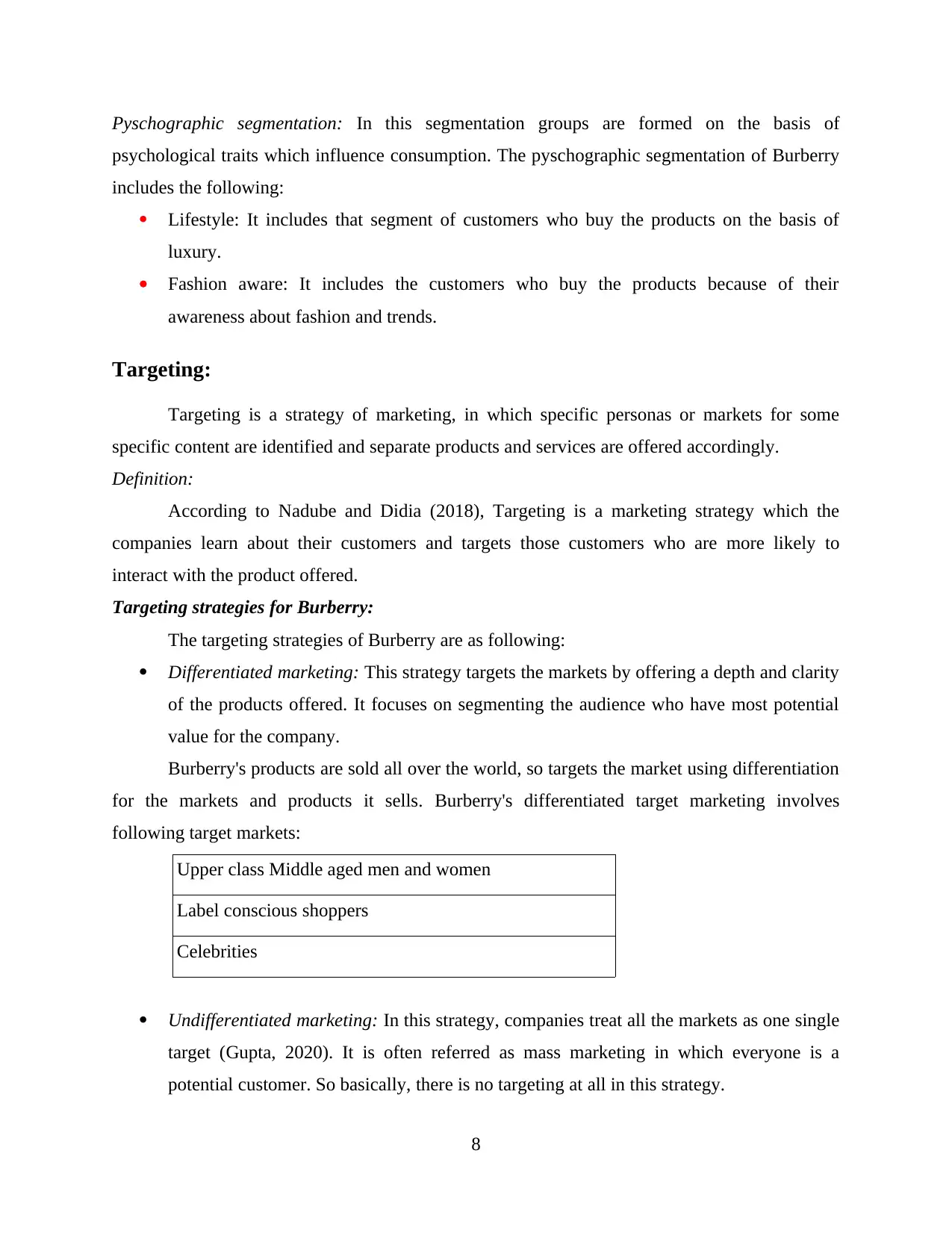
Pyschographic segmentation: In this segmentation groups are formed on the basis of
psychological traits which influence consumption. The pyschographic segmentation of Burberry
includes the following:
Lifestyle: It includes that segment of customers who buy the products on the basis of
luxury.
Fashion aware: It includes the customers who buy the products because of their
awareness about fashion and trends.
Targeting:
Targeting is a strategy of marketing, in which specific personas or markets for some
specific content are identified and separate products and services are offered accordingly.
Definition:
According to Nadube and Didia (2018), Targeting is a marketing strategy which the
companies learn about their customers and targets those customers who are more likely to
interact with the product offered.
Targeting strategies for Burberry:
The targeting strategies of Burberry are as following:
Differentiated marketing: This strategy targets the markets by offering a depth and clarity
of the products offered. It focuses on segmenting the audience who have most potential
value for the company.
Burberry's products are sold all over the world, so targets the market using differentiation
for the markets and products it sells. Burberry's differentiated target marketing involves
following target markets:
Upper class Middle aged men and women
Label conscious shoppers
Celebrities
Undifferentiated marketing: In this strategy, companies treat all the markets as one single
target (Gupta, 2020). It is often referred as mass marketing in which everyone is a
potential customer. So basically, there is no targeting at all in this strategy.
8
psychological traits which influence consumption. The pyschographic segmentation of Burberry
includes the following:
Lifestyle: It includes that segment of customers who buy the products on the basis of
luxury.
Fashion aware: It includes the customers who buy the products because of their
awareness about fashion and trends.
Targeting:
Targeting is a strategy of marketing, in which specific personas or markets for some
specific content are identified and separate products and services are offered accordingly.
Definition:
According to Nadube and Didia (2018), Targeting is a marketing strategy which the
companies learn about their customers and targets those customers who are more likely to
interact with the product offered.
Targeting strategies for Burberry:
The targeting strategies of Burberry are as following:
Differentiated marketing: This strategy targets the markets by offering a depth and clarity
of the products offered. It focuses on segmenting the audience who have most potential
value for the company.
Burberry's products are sold all over the world, so targets the market using differentiation
for the markets and products it sells. Burberry's differentiated target marketing involves
following target markets:
Upper class Middle aged men and women
Label conscious shoppers
Celebrities
Undifferentiated marketing: In this strategy, companies treat all the markets as one single
target (Gupta, 2020). It is often referred as mass marketing in which everyone is a
potential customer. So basically, there is no targeting at all in this strategy.
8
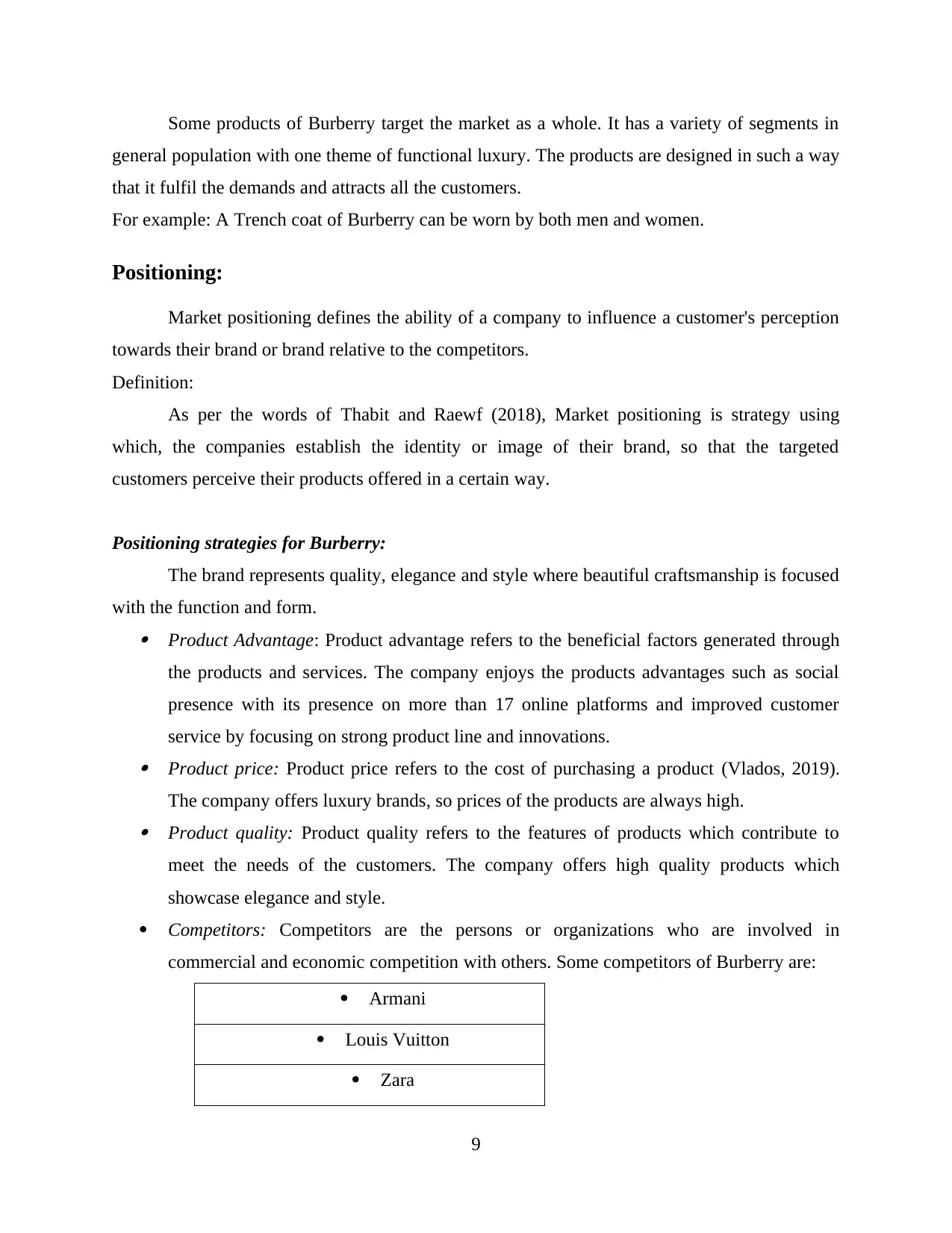
Some products of Burberry target the market as a whole. It has a variety of segments in
general population with one theme of functional luxury. The products are designed in such a way
that it fulfil the demands and attracts all the customers.
For example: A Trench coat of Burberry can be worn by both men and women.
Positioning:
Market positioning defines the ability of a company to influence a customer's perception
towards their brand or brand relative to the competitors.
Definition:
As per the words of Thabit and Raewf (2018), Market positioning is strategy using
which, the companies establish the identity or image of their brand, so that the targeted
customers perceive their products offered in a certain way.
Positioning strategies for Burberry:
The brand represents quality, elegance and style where beautiful craftsmanship is focused
with the function and form. Product Advantage: Product advantage refers to the beneficial factors generated through
the products and services. The company enjoys the products advantages such as social
presence with its presence on more than 17 online platforms and improved customer
service by focusing on strong product line and innovations. Product price: Product price refers to the cost of purchasing a product (Vlados, 2019).
The company offers luxury brands, so prices of the products are always high. Product quality: Product quality refers to the features of products which contribute to
meet the needs of the customers. The company offers high quality products which
showcase elegance and style.
Competitors: Competitors are the persons or organizations who are involved in
commercial and economic competition with others. Some competitors of Burberry are:
Armani
Louis Vuitton
Zara
9
general population with one theme of functional luxury. The products are designed in such a way
that it fulfil the demands and attracts all the customers.
For example: A Trench coat of Burberry can be worn by both men and women.
Positioning:
Market positioning defines the ability of a company to influence a customer's perception
towards their brand or brand relative to the competitors.
Definition:
As per the words of Thabit and Raewf (2018), Market positioning is strategy using
which, the companies establish the identity or image of their brand, so that the targeted
customers perceive their products offered in a certain way.
Positioning strategies for Burberry:
The brand represents quality, elegance and style where beautiful craftsmanship is focused
with the function and form. Product Advantage: Product advantage refers to the beneficial factors generated through
the products and services. The company enjoys the products advantages such as social
presence with its presence on more than 17 online platforms and improved customer
service by focusing on strong product line and innovations. Product price: Product price refers to the cost of purchasing a product (Vlados, 2019).
The company offers luxury brands, so prices of the products are always high. Product quality: Product quality refers to the features of products which contribute to
meet the needs of the customers. The company offers high quality products which
showcase elegance and style.
Competitors: Competitors are the persons or organizations who are involved in
commercial and economic competition with others. Some competitors of Burberry are:
Armani
Louis Vuitton
Zara
9
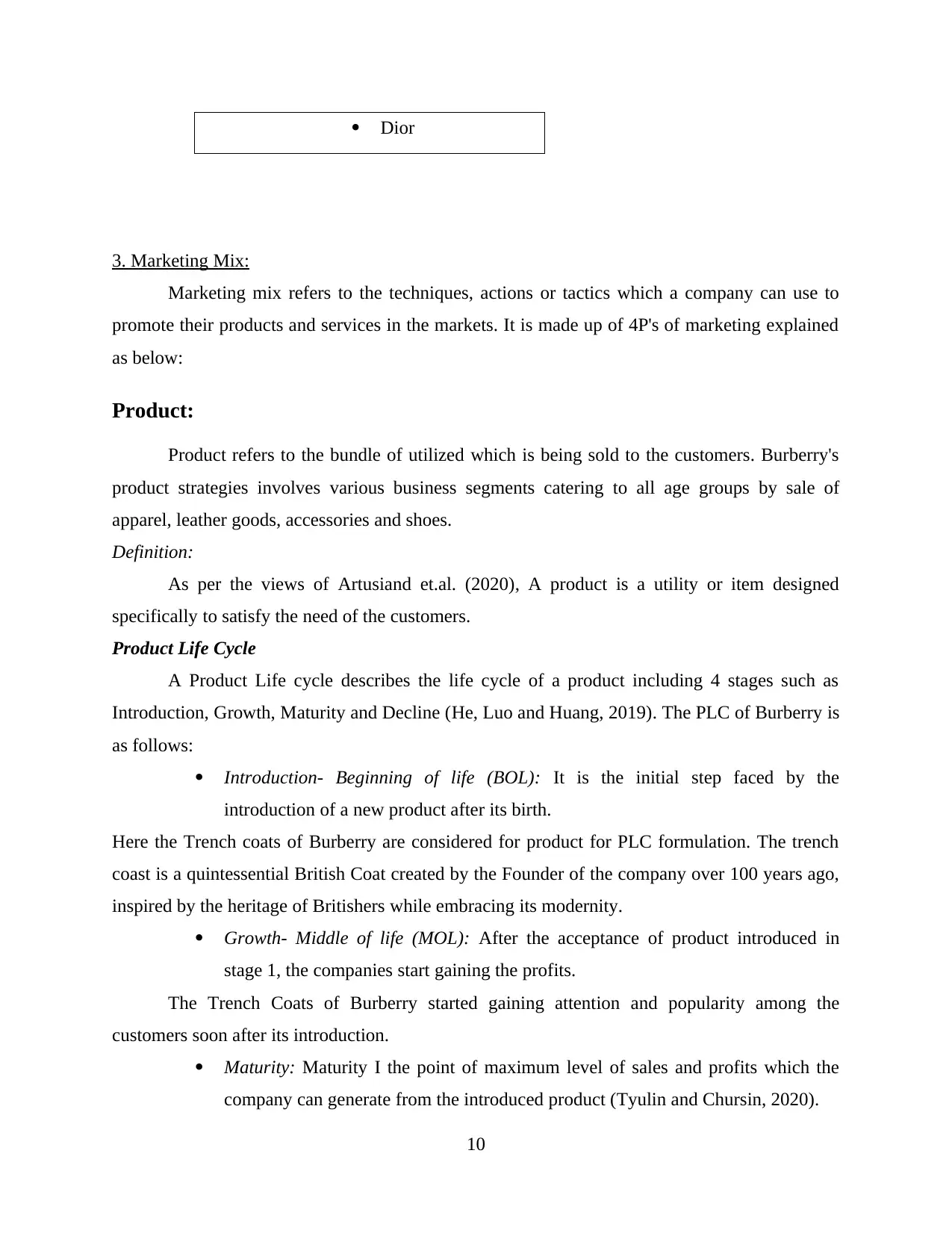
Dior
3. Marketing Mix:
Marketing mix refers to the techniques, actions or tactics which a company can use to
promote their products and services in the markets. It is made up of 4P's of marketing explained
as below:
Product:
Product refers to the bundle of utilized which is being sold to the customers. Burberry's
product strategies involves various business segments catering to all age groups by sale of
apparel, leather goods, accessories and shoes.
Definition:
As per the views of Artusiand et.al. (2020), A product is a utility or item designed
specifically to satisfy the need of the customers.
Product Life Cycle
A Product Life cycle describes the life cycle of a product including 4 stages such as
Introduction, Growth, Maturity and Decline (He, Luo and Huang, 2019). The PLC of Burberry is
as follows:
Introduction- Beginning of life (BOL): It is the initial step faced by the
introduction of a new product after its birth.
Here the Trench coats of Burberry are considered for product for PLC formulation. The trench
coast is a quintessential British Coat created by the Founder of the company over 100 years ago,
inspired by the heritage of Britishers while embracing its modernity.
Growth- Middle of life (MOL): After the acceptance of product introduced in
stage 1, the companies start gaining the profits.
The Trench Coats of Burberry started gaining attention and popularity among the
customers soon after its introduction.
Maturity: Maturity I the point of maximum level of sales and profits which the
company can generate from the introduced product (Tyulin and Chursin, 2020).
10
3. Marketing Mix:
Marketing mix refers to the techniques, actions or tactics which a company can use to
promote their products and services in the markets. It is made up of 4P's of marketing explained
as below:
Product:
Product refers to the bundle of utilized which is being sold to the customers. Burberry's
product strategies involves various business segments catering to all age groups by sale of
apparel, leather goods, accessories and shoes.
Definition:
As per the views of Artusiand et.al. (2020), A product is a utility or item designed
specifically to satisfy the need of the customers.
Product Life Cycle
A Product Life cycle describes the life cycle of a product including 4 stages such as
Introduction, Growth, Maturity and Decline (He, Luo and Huang, 2019). The PLC of Burberry is
as follows:
Introduction- Beginning of life (BOL): It is the initial step faced by the
introduction of a new product after its birth.
Here the Trench coats of Burberry are considered for product for PLC formulation. The trench
coast is a quintessential British Coat created by the Founder of the company over 100 years ago,
inspired by the heritage of Britishers while embracing its modernity.
Growth- Middle of life (MOL): After the acceptance of product introduced in
stage 1, the companies start gaining the profits.
The Trench Coats of Burberry started gaining attention and popularity among the
customers soon after its introduction.
Maturity: Maturity I the point of maximum level of sales and profits which the
company can generate from the introduced product (Tyulin and Chursin, 2020).
10
Secure Best Marks with AI Grader
Need help grading? Try our AI Grader for instant feedback on your assignments.
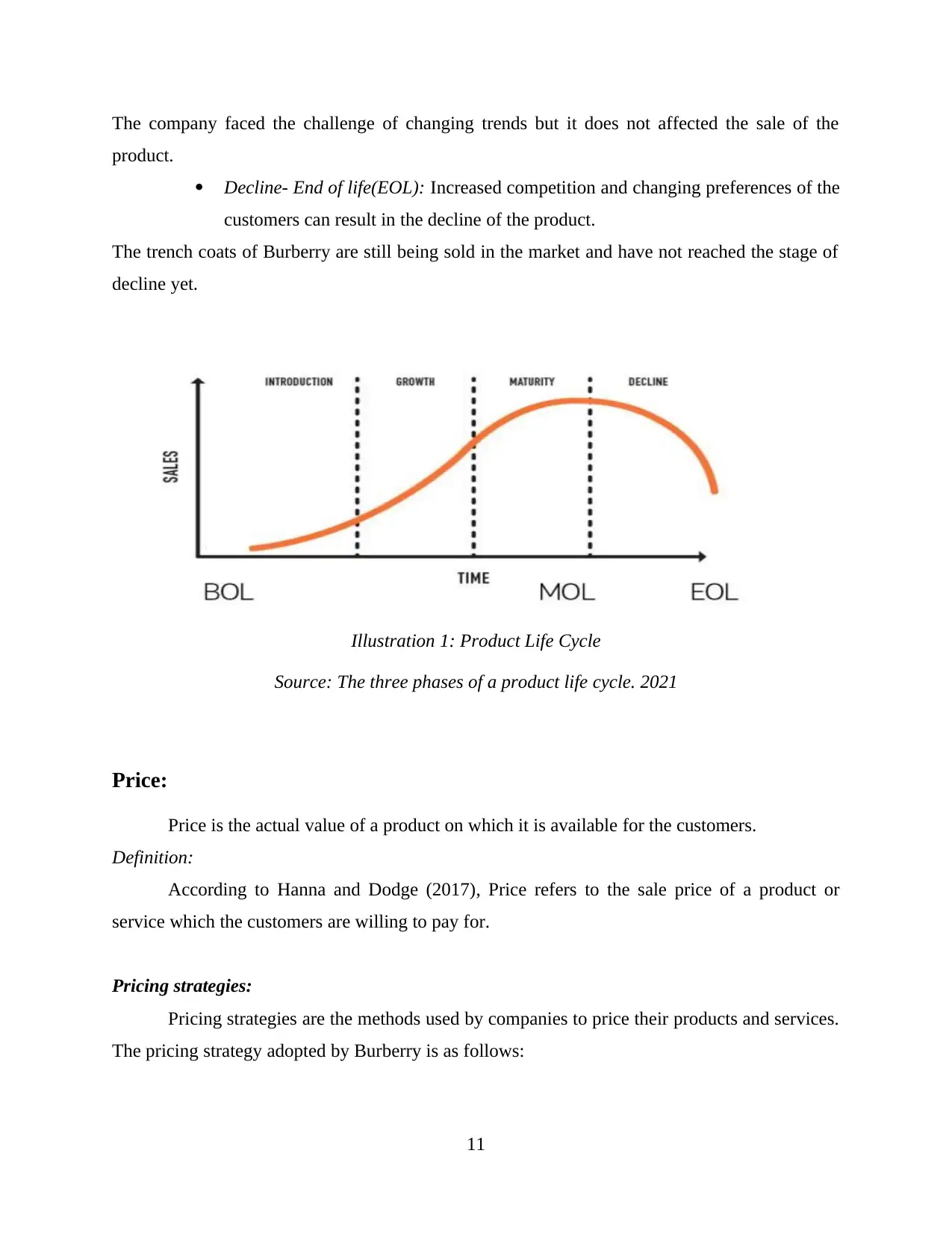
The company faced the challenge of changing trends but it does not affected the sale of the
product.
Decline- End of life(EOL): Increased competition and changing preferences of the
customers can result in the decline of the product.
The trench coats of Burberry are still being sold in the market and have not reached the stage of
decline yet.
Price:
Price is the actual value of a product on which it is available for the customers.
Definition:
According to Hanna and Dodge (2017), Price refers to the sale price of a product or
service which the customers are willing to pay for.
Pricing strategies:
Pricing strategies are the methods used by companies to price their products and services.
The pricing strategy adopted by Burberry is as follows:
11
Illustration 1: Product Life Cycle
Source: The three phases of a product life cycle. 2021
product.
Decline- End of life(EOL): Increased competition and changing preferences of the
customers can result in the decline of the product.
The trench coats of Burberry are still being sold in the market and have not reached the stage of
decline yet.
Price:
Price is the actual value of a product on which it is available for the customers.
Definition:
According to Hanna and Dodge (2017), Price refers to the sale price of a product or
service which the customers are willing to pay for.
Pricing strategies:
Pricing strategies are the methods used by companies to price their products and services.
The pricing strategy adopted by Burberry is as follows:
11
Illustration 1: Product Life Cycle
Source: The three phases of a product life cycle. 2021
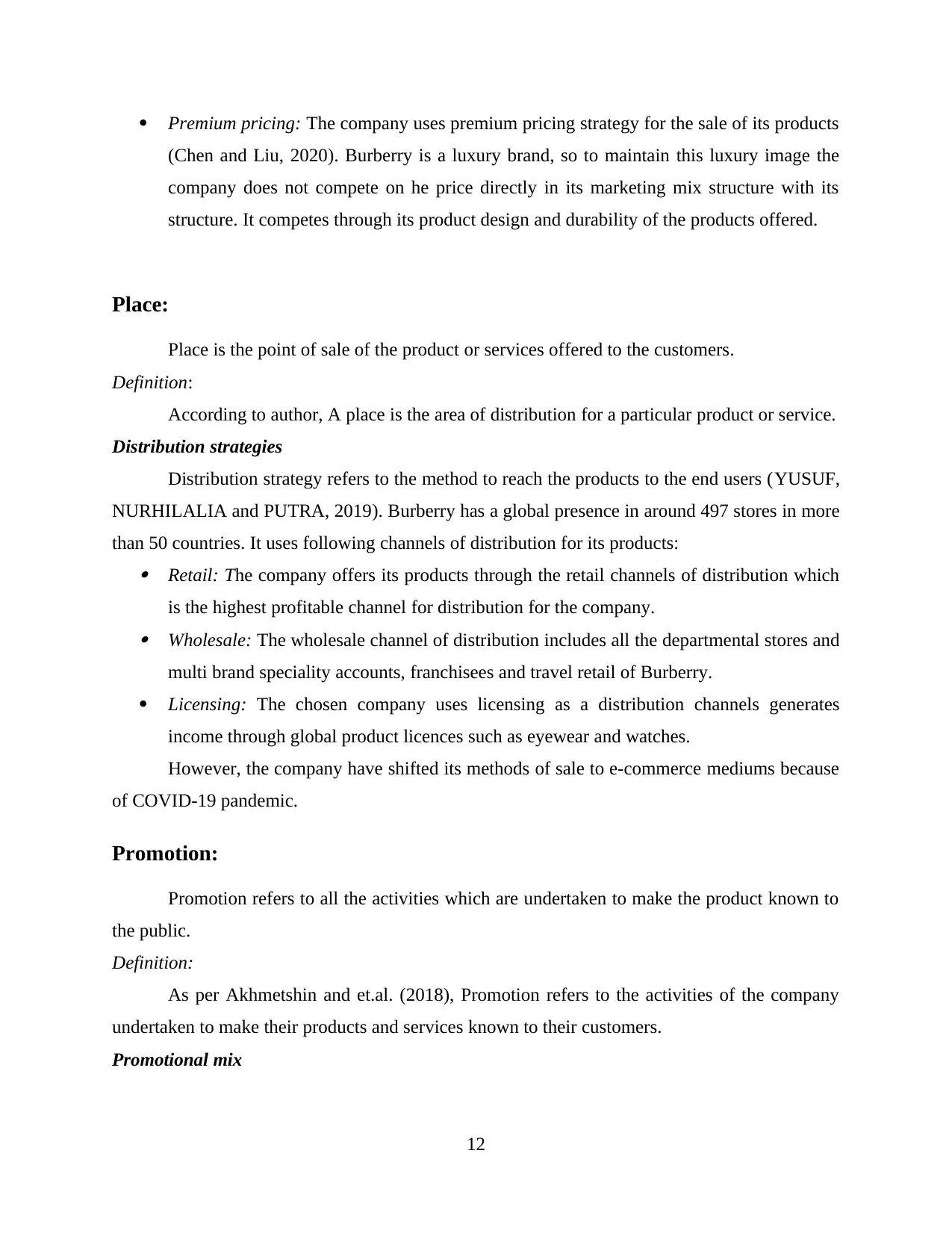
Premium pricing: The company uses premium pricing strategy for the sale of its products
(Chen and Liu, 2020). Burberry is a luxury brand, so to maintain this luxury image the
company does not compete on he price directly in its marketing mix structure with its
structure. It competes through its product design and durability of the products offered.
Place:
Place is the point of sale of the product or services offered to the customers.
Definition:
According to author, A place is the area of distribution for a particular product or service.
Distribution strategies
Distribution strategy refers to the method to reach the products to the end users (YUSUF,
NURHILALIA and PUTRA, 2019). Burberry has a global presence in around 497 stores in more
than 50 countries. It uses following channels of distribution for its products: Retail: The company offers its products through the retail channels of distribution which
is the highest profitable channel for distribution for the company. Wholesale: The wholesale channel of distribution includes all the departmental stores and
multi brand speciality accounts, franchisees and travel retail of Burberry.
Licensing: The chosen company uses licensing as a distribution channels generates
income through global product licences such as eyewear and watches.
However, the company have shifted its methods of sale to e-commerce mediums because
of COVID-19 pandemic.
Promotion:
Promotion refers to all the activities which are undertaken to make the product known to
the public.
Definition:
As per Akhmetshin and et.al. (2018), Promotion refers to the activities of the company
undertaken to make their products and services known to their customers.
Promotional mix
12
(Chen and Liu, 2020). Burberry is a luxury brand, so to maintain this luxury image the
company does not compete on he price directly in its marketing mix structure with its
structure. It competes through its product design and durability of the products offered.
Place:
Place is the point of sale of the product or services offered to the customers.
Definition:
According to author, A place is the area of distribution for a particular product or service.
Distribution strategies
Distribution strategy refers to the method to reach the products to the end users (YUSUF,
NURHILALIA and PUTRA, 2019). Burberry has a global presence in around 497 stores in more
than 50 countries. It uses following channels of distribution for its products: Retail: The company offers its products through the retail channels of distribution which
is the highest profitable channel for distribution for the company. Wholesale: The wholesale channel of distribution includes all the departmental stores and
multi brand speciality accounts, franchisees and travel retail of Burberry.
Licensing: The chosen company uses licensing as a distribution channels generates
income through global product licences such as eyewear and watches.
However, the company have shifted its methods of sale to e-commerce mediums because
of COVID-19 pandemic.
Promotion:
Promotion refers to all the activities which are undertaken to make the product known to
the public.
Definition:
As per Akhmetshin and et.al. (2018), Promotion refers to the activities of the company
undertaken to make their products and services known to their customers.
Promotional mix
12
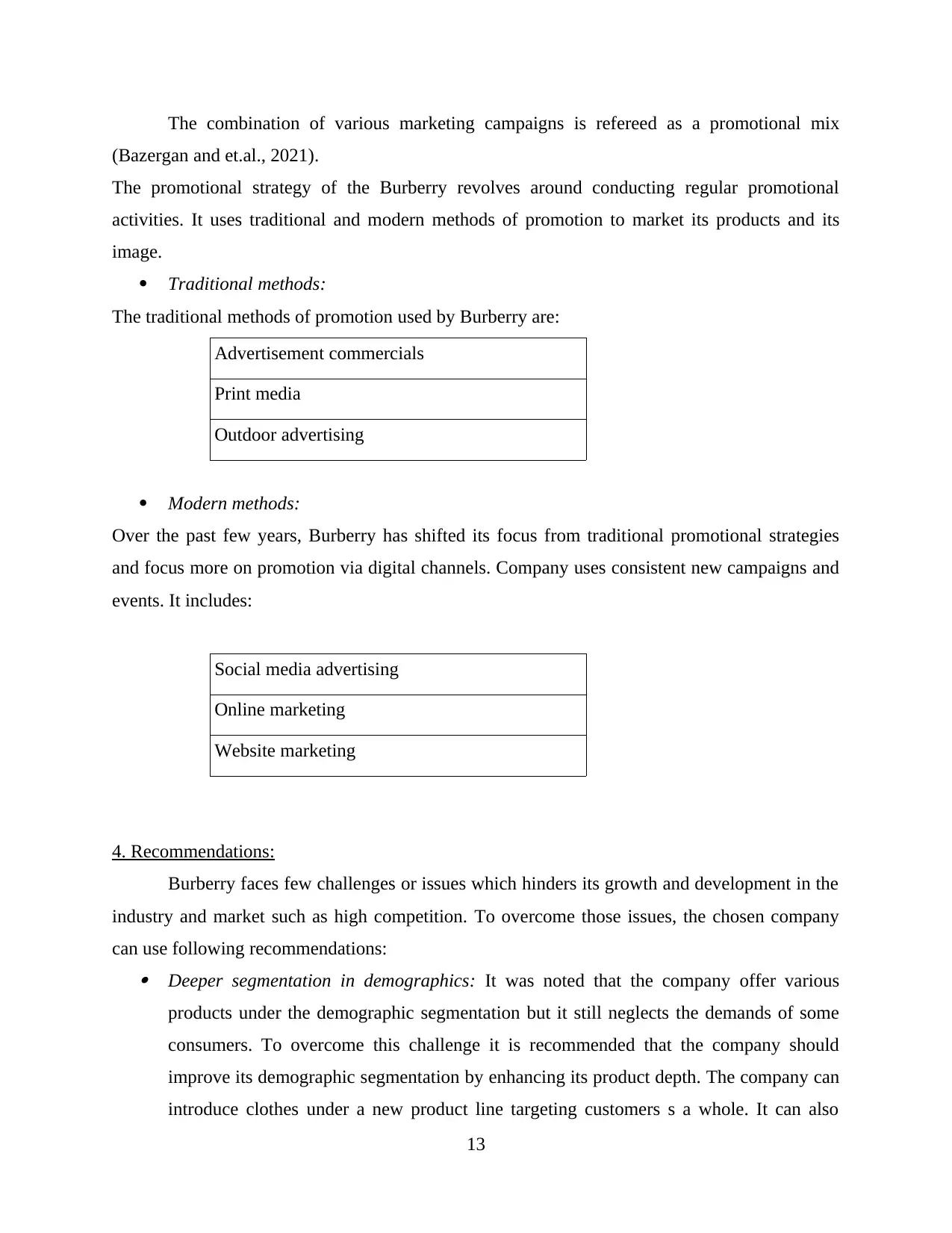
The combination of various marketing campaigns is refereed as a promotional mix
(Bazergan and et.al., 2021).
The promotional strategy of the Burberry revolves around conducting regular promotional
activities. It uses traditional and modern methods of promotion to market its products and its
image.
Traditional methods:
The traditional methods of promotion used by Burberry are:
Advertisement commercials
Print media
Outdoor advertising
Modern methods:
Over the past few years, Burberry has shifted its focus from traditional promotional strategies
and focus more on promotion via digital channels. Company uses consistent new campaigns and
events. It includes:
Social media advertising
Online marketing
Website marketing
4. Recommendations:
Burberry faces few challenges or issues which hinders its growth and development in the
industry and market such as high competition. To overcome those issues, the chosen company
can use following recommendations: Deeper segmentation in demographics: It was noted that the company offer various
products under the demographic segmentation but it still neglects the demands of some
consumers. To overcome this challenge it is recommended that the company should
improve its demographic segmentation by enhancing its product depth. The company can
introduce clothes under a new product line targeting customers s a whole. It can also
13
(Bazergan and et.al., 2021).
The promotional strategy of the Burberry revolves around conducting regular promotional
activities. It uses traditional and modern methods of promotion to market its products and its
image.
Traditional methods:
The traditional methods of promotion used by Burberry are:
Advertisement commercials
Print media
Outdoor advertising
Modern methods:
Over the past few years, Burberry has shifted its focus from traditional promotional strategies
and focus more on promotion via digital channels. Company uses consistent new campaigns and
events. It includes:
Social media advertising
Online marketing
Website marketing
4. Recommendations:
Burberry faces few challenges or issues which hinders its growth and development in the
industry and market such as high competition. To overcome those issues, the chosen company
can use following recommendations: Deeper segmentation in demographics: It was noted that the company offer various
products under the demographic segmentation but it still neglects the demands of some
consumers. To overcome this challenge it is recommended that the company should
improve its demographic segmentation by enhancing its product depth. The company can
introduce clothes under a new product line targeting customers s a whole. It can also
13
Paraphrase This Document
Need a fresh take? Get an instant paraphrase of this document with our AI Paraphraser
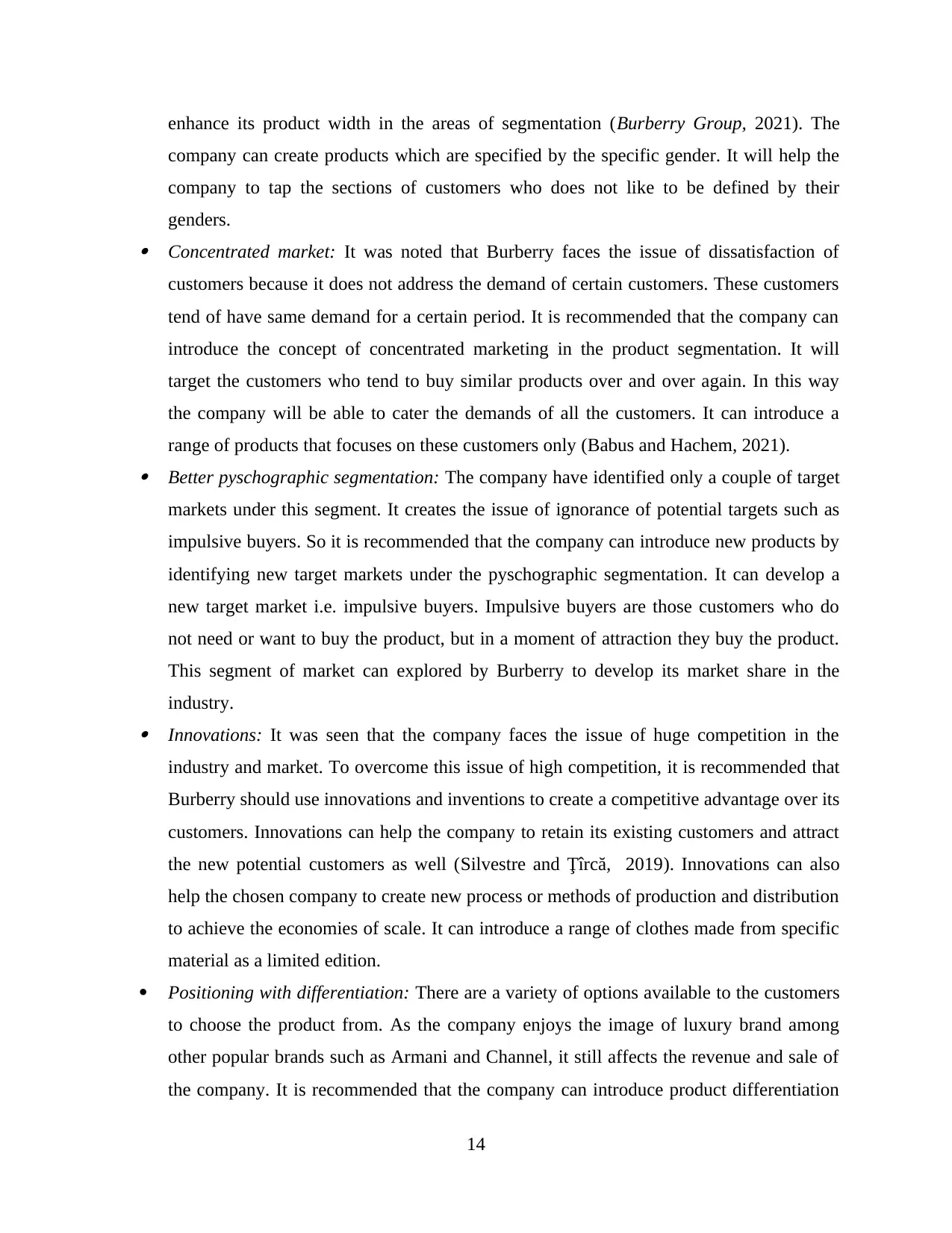
enhance its product width in the areas of segmentation (Burberry Group, 2021). The
company can create products which are specified by the specific gender. It will help the
company to tap the sections of customers who does not like to be defined by their
genders. Concentrated market: It was noted that Burberry faces the issue of dissatisfaction of
customers because it does not address the demand of certain customers. These customers
tend of have same demand for a certain period. It is recommended that the company can
introduce the concept of concentrated marketing in the product segmentation. It will
target the customers who tend to buy similar products over and over again. In this way
the company will be able to cater the demands of all the customers. It can introduce a
range of products that focuses on these customers only (Babus and Hachem, 2021). Better pyschographic segmentation: The company have identified only a couple of target
markets under this segment. It creates the issue of ignorance of potential targets such as
impulsive buyers. So it is recommended that the company can introduce new products by
identifying new target markets under the pyschographic segmentation. It can develop a
new target market i.e. impulsive buyers. Impulsive buyers are those customers who do
not need or want to buy the product, but in a moment of attraction they buy the product.
This segment of market can explored by Burberry to develop its market share in the
industry. Innovations: It was seen that the company faces the issue of huge competition in the
industry and market. To overcome this issue of high competition, it is recommended that
Burberry should use innovations and inventions to create a competitive advantage over its
customers. Innovations can help the company to retain its existing customers and attract
the new potential customers as well (Silvestre and Ţîrcă, 2019). Innovations can also
help the chosen company to create new process or methods of production and distribution
to achieve the economies of scale. It can introduce a range of clothes made from specific
material as a limited edition.
Positioning with differentiation: There are a variety of options available to the customers
to choose the product from. As the company enjoys the image of luxury brand among
other popular brands such as Armani and Channel, it still affects the revenue and sale of
the company. It is recommended that the company can introduce product differentiation
14
company can create products which are specified by the specific gender. It will help the
company to tap the sections of customers who does not like to be defined by their
genders. Concentrated market: It was noted that Burberry faces the issue of dissatisfaction of
customers because it does not address the demand of certain customers. These customers
tend of have same demand for a certain period. It is recommended that the company can
introduce the concept of concentrated marketing in the product segmentation. It will
target the customers who tend to buy similar products over and over again. In this way
the company will be able to cater the demands of all the customers. It can introduce a
range of products that focuses on these customers only (Babus and Hachem, 2021). Better pyschographic segmentation: The company have identified only a couple of target
markets under this segment. It creates the issue of ignorance of potential targets such as
impulsive buyers. So it is recommended that the company can introduce new products by
identifying new target markets under the pyschographic segmentation. It can develop a
new target market i.e. impulsive buyers. Impulsive buyers are those customers who do
not need or want to buy the product, but in a moment of attraction they buy the product.
This segment of market can explored by Burberry to develop its market share in the
industry. Innovations: It was seen that the company faces the issue of huge competition in the
industry and market. To overcome this issue of high competition, it is recommended that
Burberry should use innovations and inventions to create a competitive advantage over its
customers. Innovations can help the company to retain its existing customers and attract
the new potential customers as well (Silvestre and Ţîrcă, 2019). Innovations can also
help the chosen company to create new process or methods of production and distribution
to achieve the economies of scale. It can introduce a range of clothes made from specific
material as a limited edition.
Positioning with differentiation: There are a variety of options available to the customers
to choose the product from. As the company enjoys the image of luxury brand among
other popular brands such as Armani and Channel, it still affects the revenue and sale of
the company. It is recommended that the company can introduce product differentiation
14
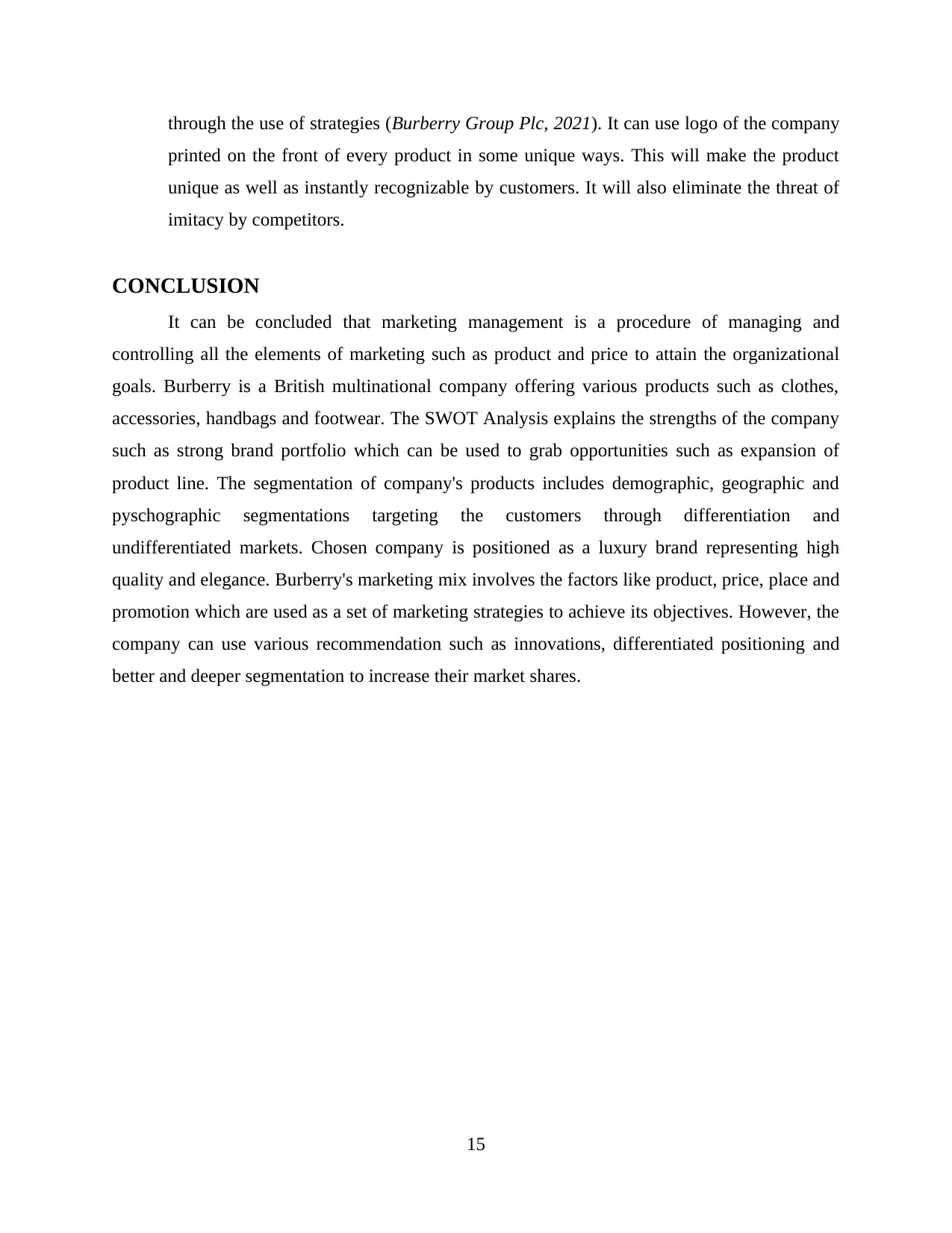
through the use of strategies (Burberry Group Plc, 2021). It can use logo of the company
printed on the front of every product in some unique ways. This will make the product
unique as well as instantly recognizable by customers. It will also eliminate the threat of
imitacy by competitors.
CONCLUSION
It can be concluded that marketing management is a procedure of managing and
controlling all the elements of marketing such as product and price to attain the organizational
goals. Burberry is a British multinational company offering various products such as clothes,
accessories, handbags and footwear. The SWOT Analysis explains the strengths of the company
such as strong brand portfolio which can be used to grab opportunities such as expansion of
product line. The segmentation of company's products includes demographic, geographic and
pyschographic segmentations targeting the customers through differentiation and
undifferentiated markets. Chosen company is positioned as a luxury brand representing high
quality and elegance. Burberry's marketing mix involves the factors like product, price, place and
promotion which are used as a set of marketing strategies to achieve its objectives. However, the
company can use various recommendation such as innovations, differentiated positioning and
better and deeper segmentation to increase their market shares.
15
printed on the front of every product in some unique ways. This will make the product
unique as well as instantly recognizable by customers. It will also eliminate the threat of
imitacy by competitors.
CONCLUSION
It can be concluded that marketing management is a procedure of managing and
controlling all the elements of marketing such as product and price to attain the organizational
goals. Burberry is a British multinational company offering various products such as clothes,
accessories, handbags and footwear. The SWOT Analysis explains the strengths of the company
such as strong brand portfolio which can be used to grab opportunities such as expansion of
product line. The segmentation of company's products includes demographic, geographic and
pyschographic segmentations targeting the customers through differentiation and
undifferentiated markets. Chosen company is positioned as a luxury brand representing high
quality and elegance. Burberry's marketing mix involves the factors like product, price, place and
promotion which are used as a set of marketing strategies to achieve its objectives. However, the
company can use various recommendation such as innovations, differentiated positioning and
better and deeper segmentation to increase their market shares.
15
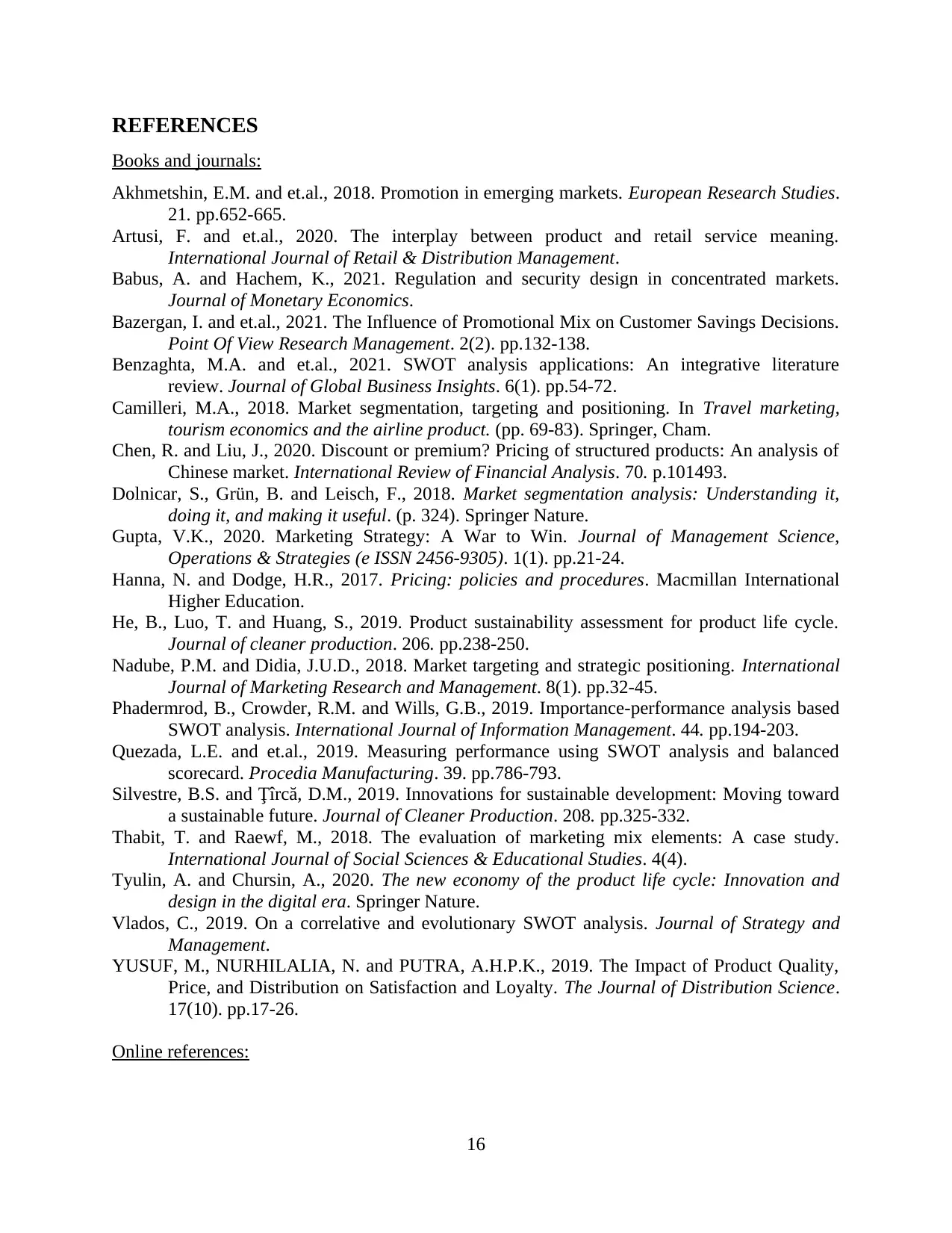
REFERENCES
Books and journals:
Akhmetshin, E.M. and et.al., 2018. Promotion in emerging markets. European Research Studies.
21. pp.652-665.
Artusi, F. and et.al., 2020. The interplay between product and retail service meaning.
International Journal of Retail & Distribution Management.
Babus, A. and Hachem, K., 2021. Regulation and security design in concentrated markets.
Journal of Monetary Economics.
Bazergan, I. and et.al., 2021. The Influence of Promotional Mix on Customer Savings Decisions.
Point Of View Research Management. 2(2). pp.132-138.
Benzaghta, M.A. and et.al., 2021. SWOT analysis applications: An integrative literature
review. Journal of Global Business Insights. 6(1). pp.54-72.
Camilleri, M.A., 2018. Market segmentation, targeting and positioning. In Travel marketing,
tourism economics and the airline product. (pp. 69-83). Springer, Cham.
Chen, R. and Liu, J., 2020. Discount or premium? Pricing of structured products: An analysis of
Chinese market. International Review of Financial Analysis. 70. p.101493.
Dolnicar, S., Grün, B. and Leisch, F., 2018. Market segmentation analysis: Understanding it,
doing it, and making it useful. (p. 324). Springer Nature.
Gupta, V.K., 2020. Marketing Strategy: A War to Win. Journal of Management Science,
Operations & Strategies (e ISSN 2456-9305). 1(1). pp.21-24.
Hanna, N. and Dodge, H.R., 2017. Pricing: policies and procedures. Macmillan International
Higher Education.
He, B., Luo, T. and Huang, S., 2019. Product sustainability assessment for product life cycle.
Journal of cleaner production. 206. pp.238-250.
Nadube, P.M. and Didia, J.U.D., 2018. Market targeting and strategic positioning. International
Journal of Marketing Research and Management. 8(1). pp.32-45.
Phadermrod, B., Crowder, R.M. and Wills, G.B., 2019. Importance-performance analysis based
SWOT analysis. International Journal of Information Management. 44. pp.194-203.
Quezada, L.E. and et.al., 2019. Measuring performance using SWOT analysis and balanced
scorecard. Procedia Manufacturing. 39. pp.786-793.
Silvestre, B.S. and Ţîrcă, D.M., 2019. Innovations for sustainable development: Moving toward
a sustainable future. Journal of Cleaner Production. 208. pp.325-332.
Thabit, T. and Raewf, M., 2018. The evaluation of marketing mix elements: A case study.
International Journal of Social Sciences & Educational Studies. 4(4).
Tyulin, A. and Chursin, A., 2020. The new economy of the product life cycle: Innovation and
design in the digital era. Springer Nature.
Vlados, C., 2019. On a correlative and evolutionary SWOT analysis. Journal of Strategy and
Management.
YUSUF, M., NURHILALIA, N. and PUTRA, A.H.P.K., 2019. The Impact of Product Quality,
Price, and Distribution on Satisfaction and Loyalty. The Journal of Distribution Science.
17(10). pp.17-26.
Online references:
16
Books and journals:
Akhmetshin, E.M. and et.al., 2018. Promotion in emerging markets. European Research Studies.
21. pp.652-665.
Artusi, F. and et.al., 2020. The interplay between product and retail service meaning.
International Journal of Retail & Distribution Management.
Babus, A. and Hachem, K., 2021. Regulation and security design in concentrated markets.
Journal of Monetary Economics.
Bazergan, I. and et.al., 2021. The Influence of Promotional Mix on Customer Savings Decisions.
Point Of View Research Management. 2(2). pp.132-138.
Benzaghta, M.A. and et.al., 2021. SWOT analysis applications: An integrative literature
review. Journal of Global Business Insights. 6(1). pp.54-72.
Camilleri, M.A., 2018. Market segmentation, targeting and positioning. In Travel marketing,
tourism economics and the airline product. (pp. 69-83). Springer, Cham.
Chen, R. and Liu, J., 2020. Discount or premium? Pricing of structured products: An analysis of
Chinese market. International Review of Financial Analysis. 70. p.101493.
Dolnicar, S., Grün, B. and Leisch, F., 2018. Market segmentation analysis: Understanding it,
doing it, and making it useful. (p. 324). Springer Nature.
Gupta, V.K., 2020. Marketing Strategy: A War to Win. Journal of Management Science,
Operations & Strategies (e ISSN 2456-9305). 1(1). pp.21-24.
Hanna, N. and Dodge, H.R., 2017. Pricing: policies and procedures. Macmillan International
Higher Education.
He, B., Luo, T. and Huang, S., 2019. Product sustainability assessment for product life cycle.
Journal of cleaner production. 206. pp.238-250.
Nadube, P.M. and Didia, J.U.D., 2018. Market targeting and strategic positioning. International
Journal of Marketing Research and Management. 8(1). pp.32-45.
Phadermrod, B., Crowder, R.M. and Wills, G.B., 2019. Importance-performance analysis based
SWOT analysis. International Journal of Information Management. 44. pp.194-203.
Quezada, L.E. and et.al., 2019. Measuring performance using SWOT analysis and balanced
scorecard. Procedia Manufacturing. 39. pp.786-793.
Silvestre, B.S. and Ţîrcă, D.M., 2019. Innovations for sustainable development: Moving toward
a sustainable future. Journal of Cleaner Production. 208. pp.325-332.
Thabit, T. and Raewf, M., 2018. The evaluation of marketing mix elements: A case study.
International Journal of Social Sciences & Educational Studies. 4(4).
Tyulin, A. and Chursin, A., 2020. The new economy of the product life cycle: Innovation and
design in the digital era. Springer Nature.
Vlados, C., 2019. On a correlative and evolutionary SWOT analysis. Journal of Strategy and
Management.
YUSUF, M., NURHILALIA, N. and PUTRA, A.H.P.K., 2019. The Impact of Product Quality,
Price, and Distribution on Satisfaction and Loyalty. The Journal of Distribution Science.
17(10). pp.17-26.
Online references:
16
Secure Best Marks with AI Grader
Need help grading? Try our AI Grader for instant feedback on your assignments.
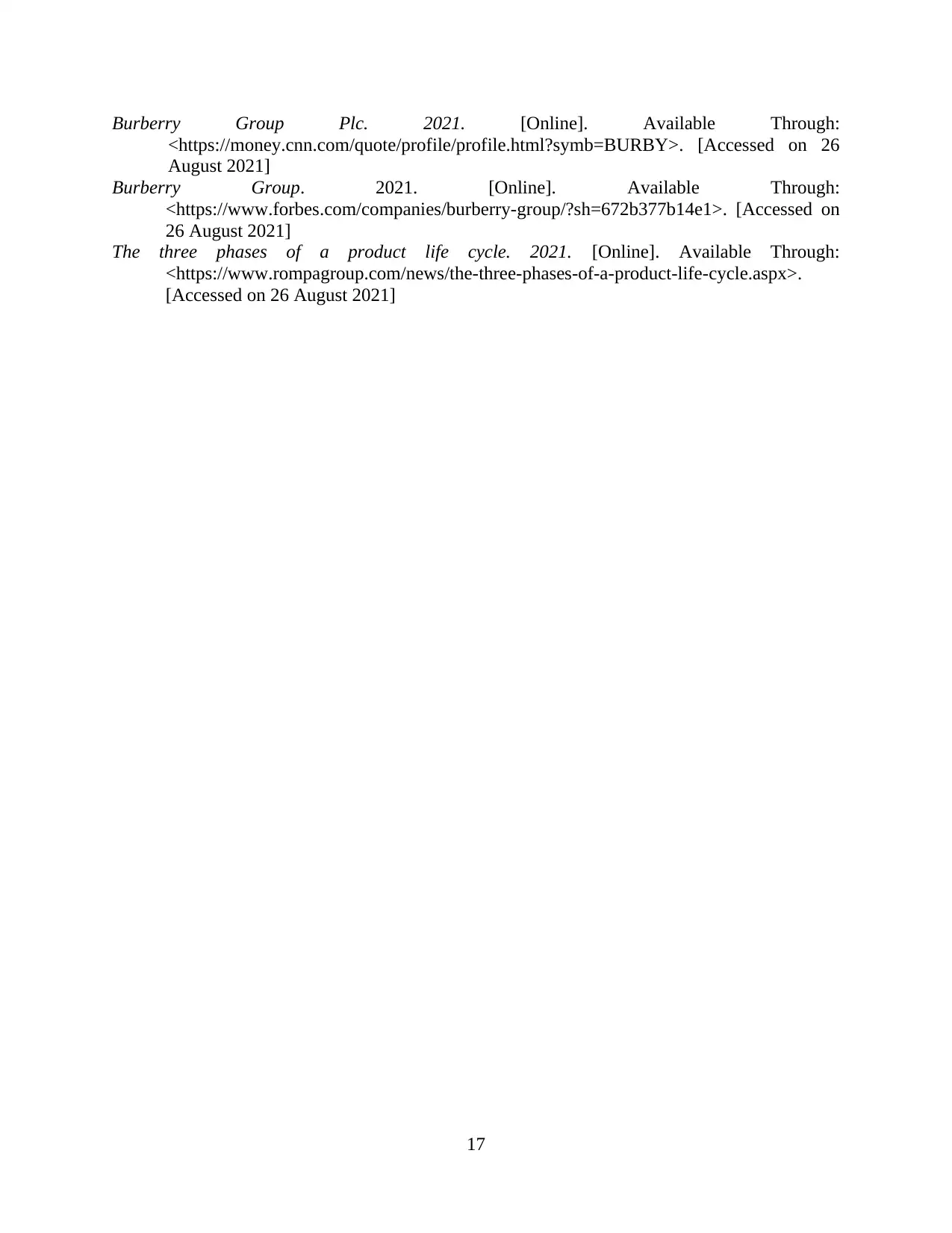
Burberry Group Plc. 2021. [Online]. Available Through:
<https://money.cnn.com/quote/profile/profile.html?symb=BURBY>. [Accessed on 26
August 2021]
Burberry Group. 2021. [Online]. Available Through:
<https://www.forbes.com/companies/burberry-group/?sh=672b377b14e1>. [Accessed on
26 August 2021]
The three phases of a product life cycle. 2021. [Online]. Available Through:
<https://www.rompagroup.com/news/the-three-phases-of-a-product-life-cycle.aspx>.
[Accessed on 26 August 2021]
17
<https://money.cnn.com/quote/profile/profile.html?symb=BURBY>. [Accessed on 26
August 2021]
Burberry Group. 2021. [Online]. Available Through:
<https://www.forbes.com/companies/burberry-group/?sh=672b377b14e1>. [Accessed on
26 August 2021]
The three phases of a product life cycle. 2021. [Online]. Available Through:
<https://www.rompagroup.com/news/the-three-phases-of-a-product-life-cycle.aspx>.
[Accessed on 26 August 2021]
17
1 out of 17
Related Documents
Your All-in-One AI-Powered Toolkit for Academic Success.
+13062052269
info@desklib.com
Available 24*7 on WhatsApp / Email
![[object Object]](/_next/static/media/star-bottom.7253800d.svg)
Unlock your academic potential
© 2024 | Zucol Services PVT LTD | All rights reserved.





